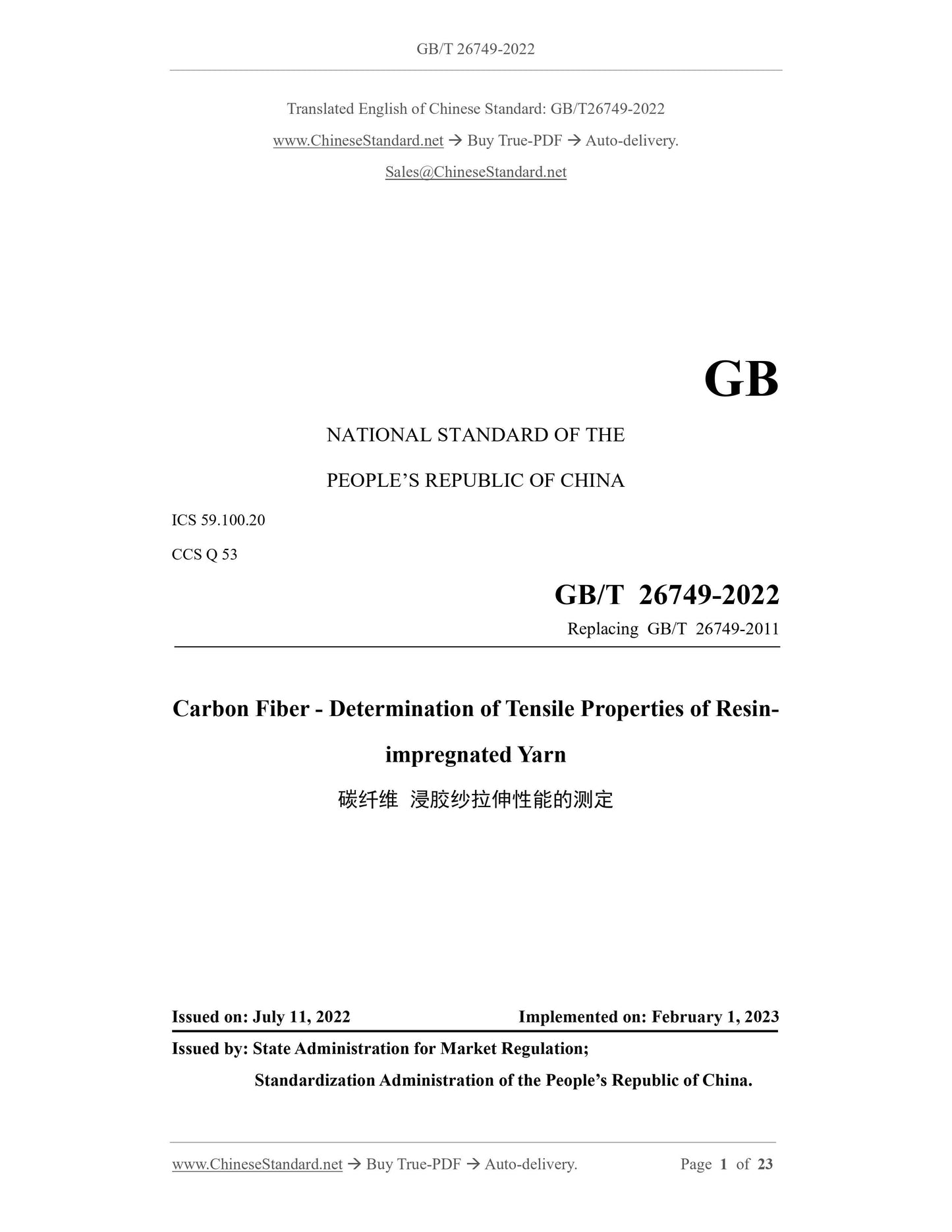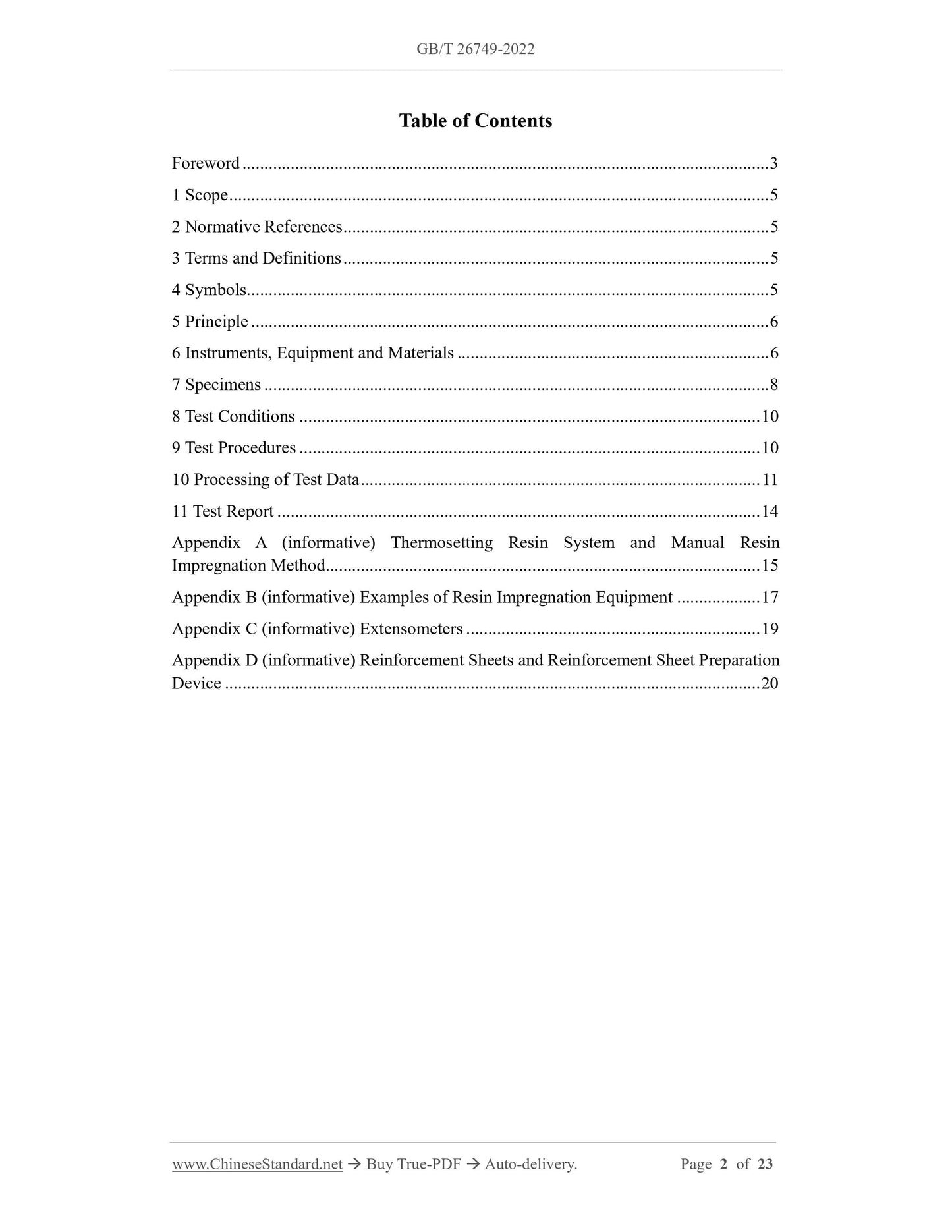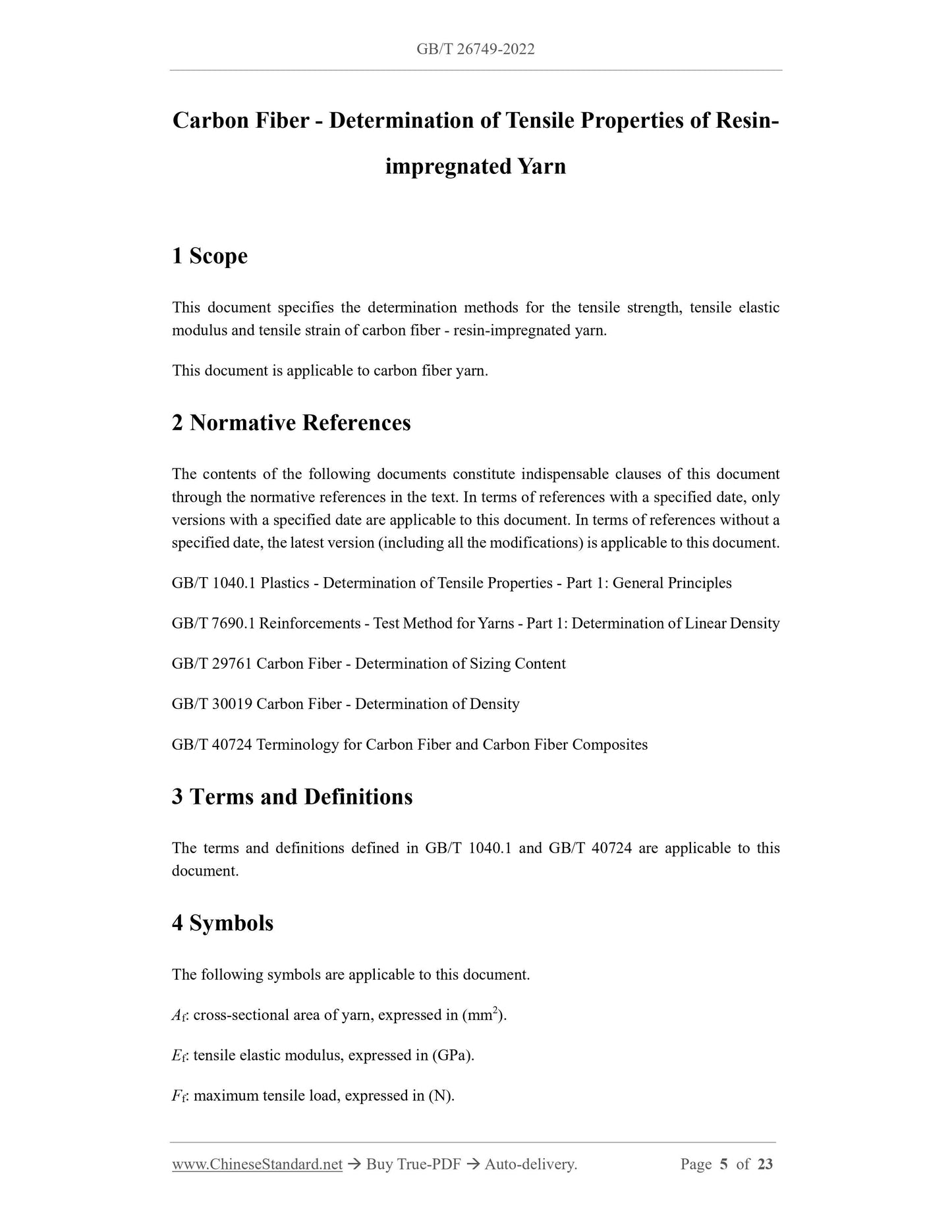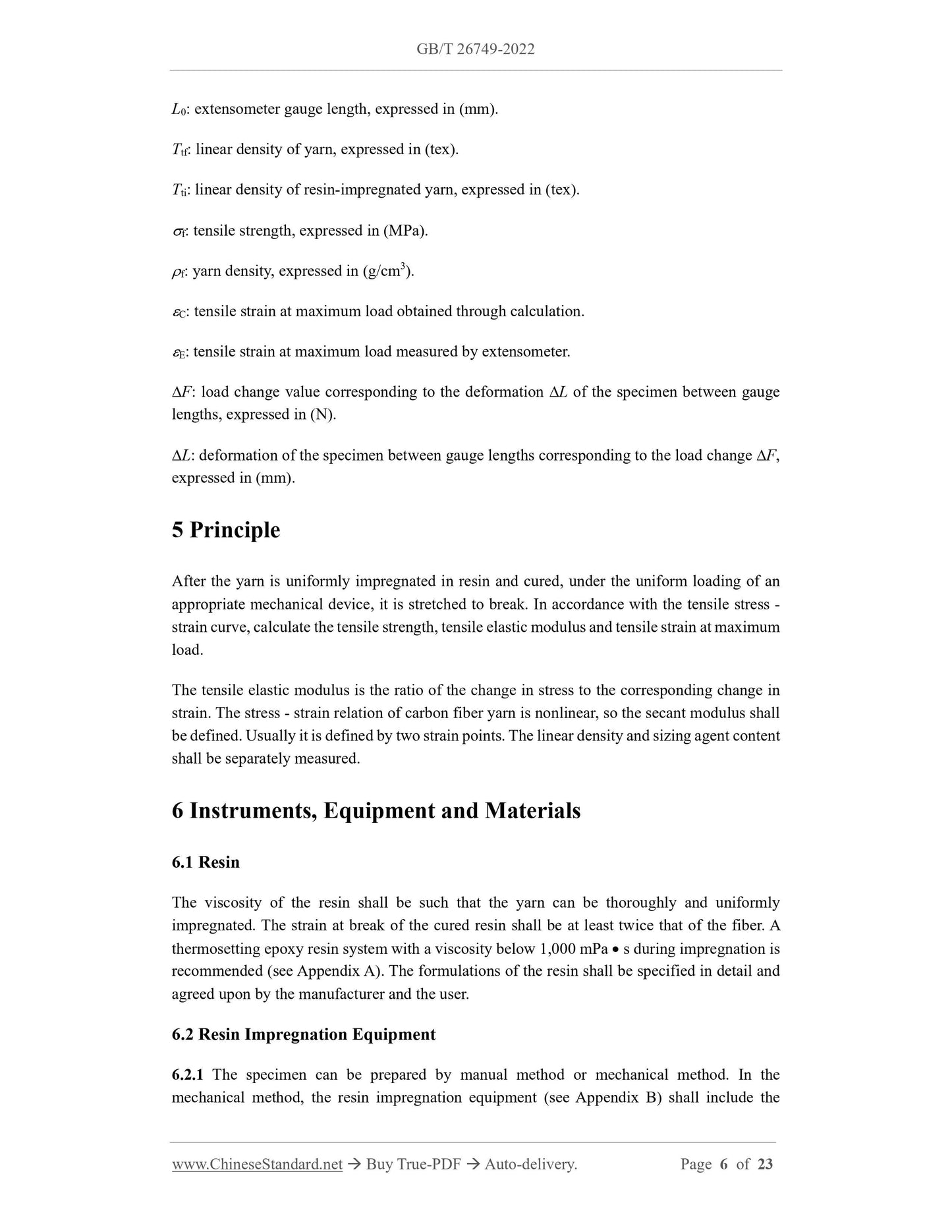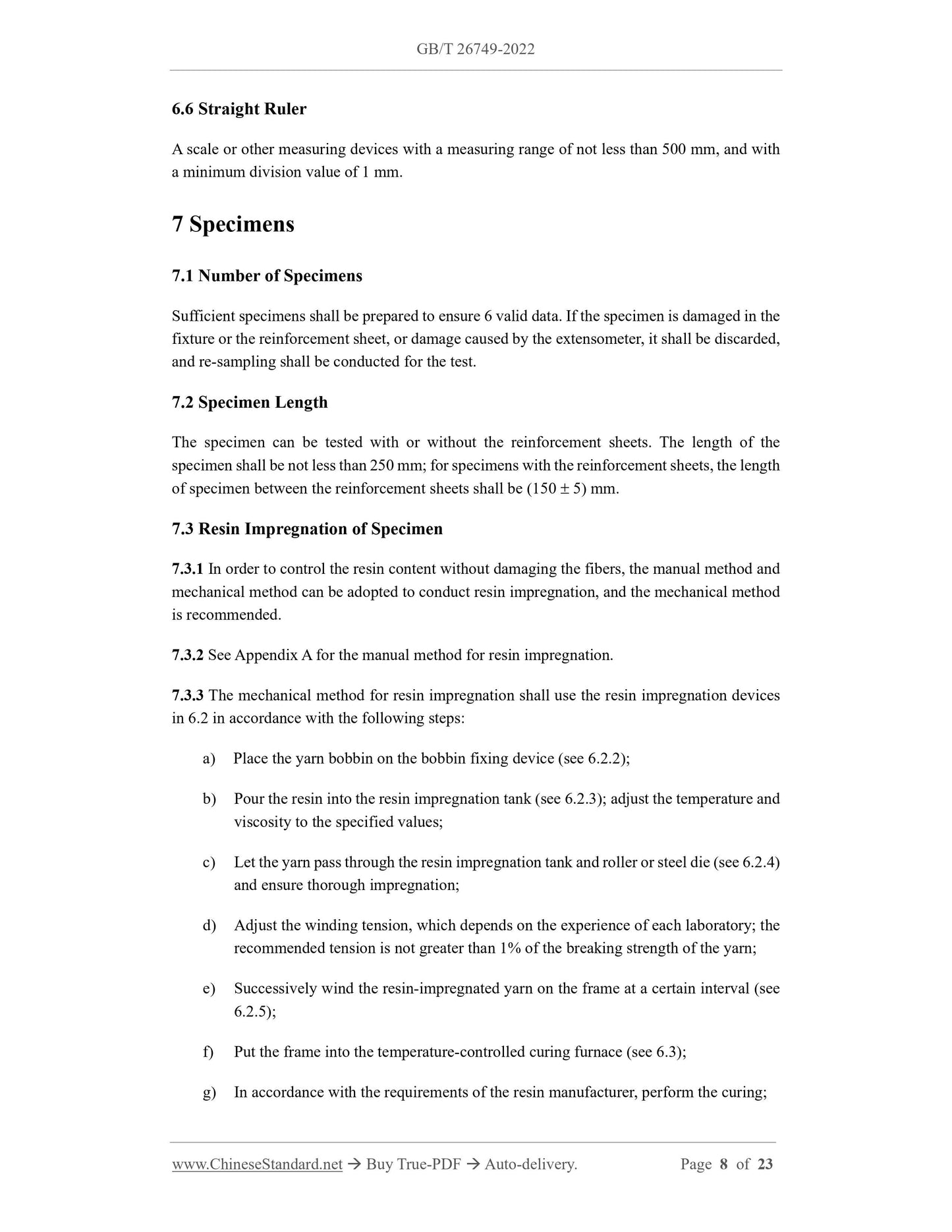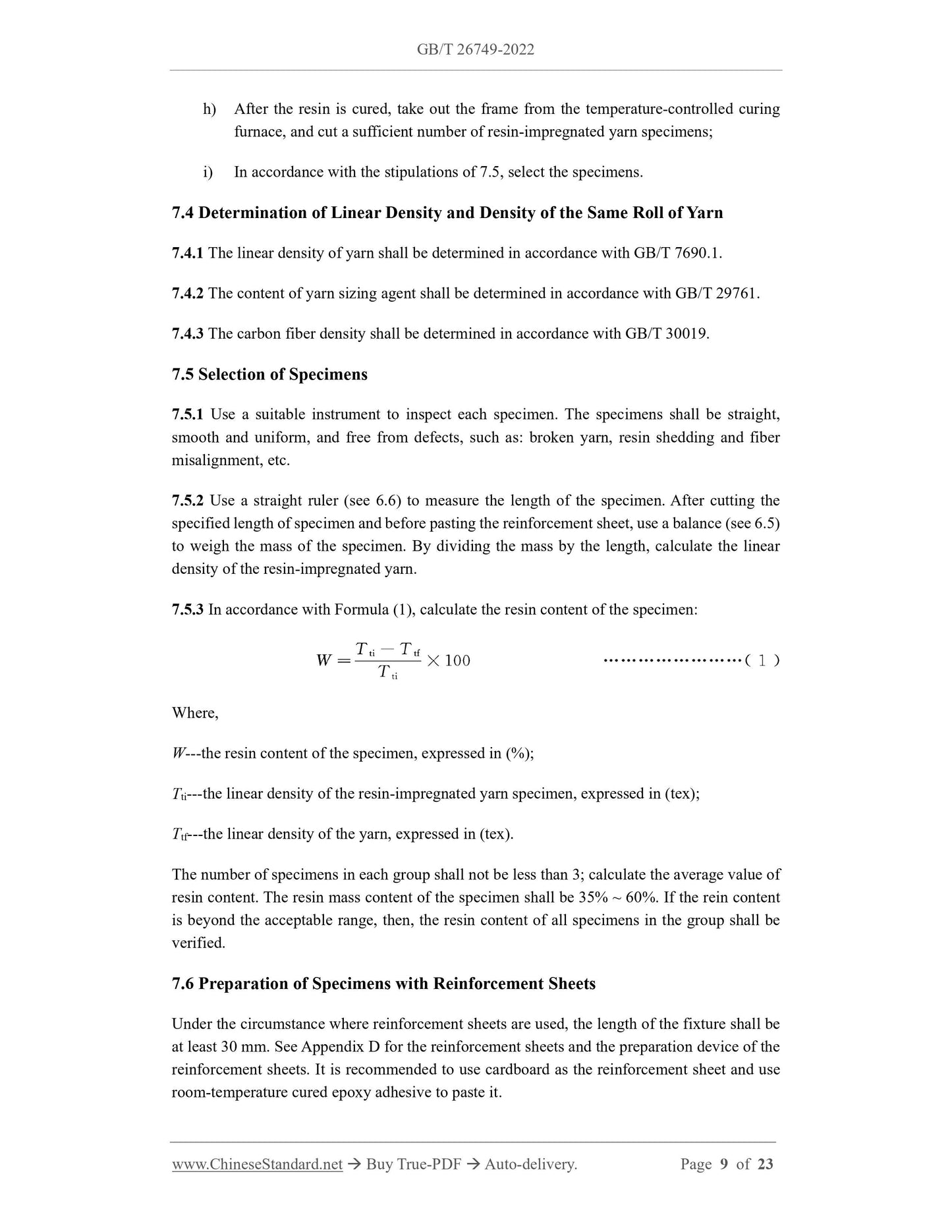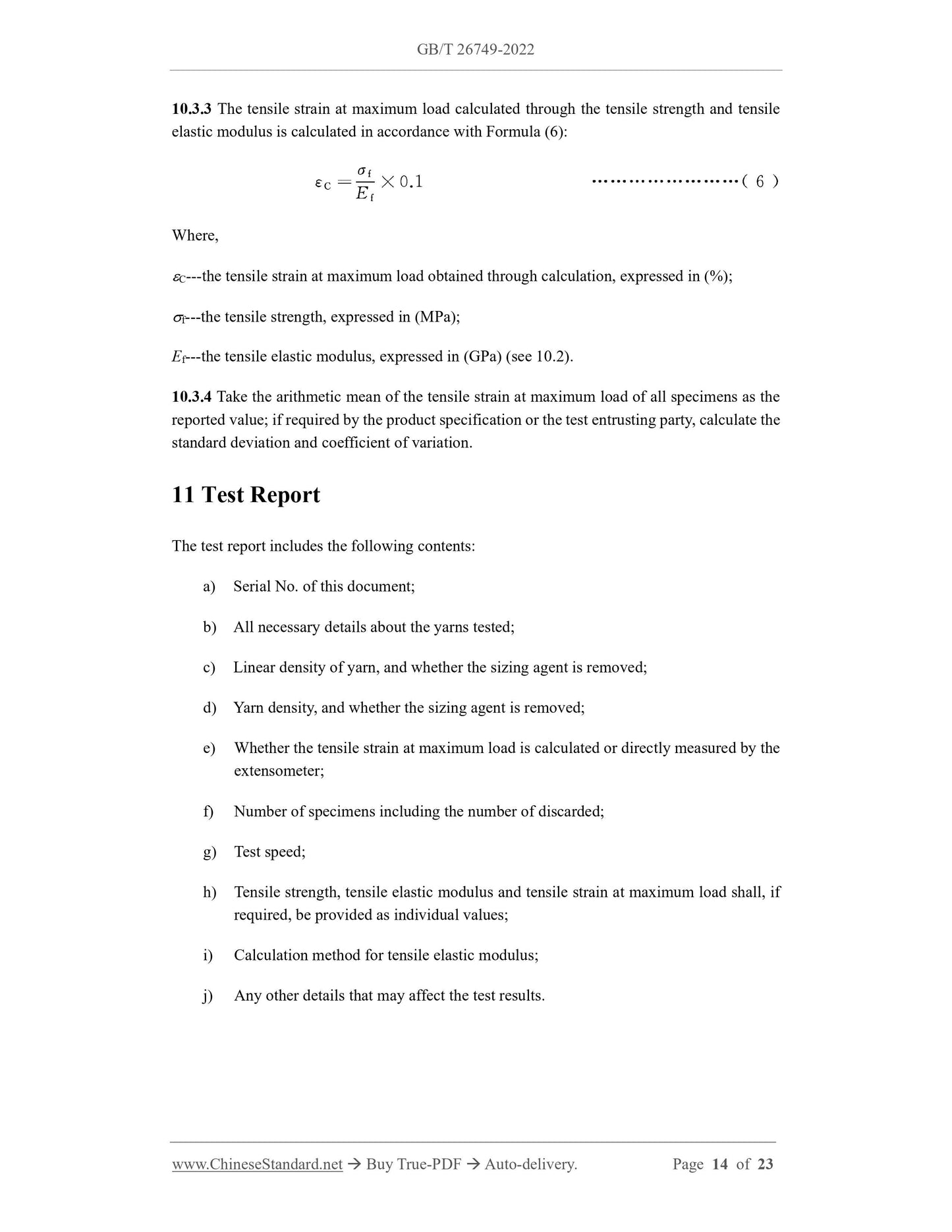1
/
of
7
PayPal, credit cards. Download editable-PDF and invoice in 1 second!
GB/T 26749-2022 English PDF (GBT26749-2022)
GB/T 26749-2022 English PDF (GBT26749-2022)
Regular price
$275.00 USD
Regular price
Sale price
$275.00 USD
Unit price
/
per
Shipping calculated at checkout.
Couldn't load pickup availability
Delivery: 3 seconds. Download true-PDF + Invoice.
Get QUOTATION in 1-minute: Click GB/T 26749-2022
Historical versions: GB/T 26749-2022
Preview True-PDF (Reload/Scroll if blank)
GB/T 26749-2022: Carbon fibre - Determination of tensile properties of resin-impregnated yarn
GB/T 26749-2022
GB
NATIONAL STANDARD OF THE
PEOPLE’S REPUBLIC OF CHINA
ICS 59.100.20
CCS Q 53
Replacing GB/T 26749-2011
Carbon Fiber - Determination of Tensile Properties of Resin-
impregnated Yarn
ISSUED ON: JULY 11, 2022
IMPLEMENTED ON: FEBRUARY 1, 2023
Issued by: State Administration for Market Regulation;
Standardization Administration of the People’s Republic of China.
Table of Contents
Foreword ... 3
1 Scope ... 5
2 Normative References ... 5
3 Terms and Definitions ... 5
4 Symbols ... 5
5 Principle ... 6
6 Instruments, Equipment and Materials ... 6
7 Specimens ... 8
8 Test Conditions ... 10
9 Test Procedures ... 10
10 Processing of Test Data ... 11
11 Test Report ... 14
Appendix A (informative) Thermosetting Resin System and Manual Resin
Impregnation Method ... 15
Appendix B (informative) Examples of Resin Impregnation Equipment ... 17
Appendix C (informative) Extensometers ... 19
Appendix D (informative) Reinforcement Sheets and Reinforcement Sheet Preparation
Device ... 20
Carbon Fiber - Determination of Tensile Properties of Resin-
impregnated Yarn
1 Scope
This document specifies the determination methods for the tensile strength, tensile elastic
modulus and tensile strain of carbon fiber - resin-impregnated yarn.
This document is applicable to carbon fiber yarn.
2 Normative References
The contents of the following documents constitute indispensable clauses of this document
through the normative references in the text. In terms of references with a specified date, only
versions with a specified date are applicable to this document. In terms of references without a
specified date, the latest version (including all the modifications) is applicable to this document.
GB/T 1040.1 Plastics - Determination of Tensile Properties - Part 1: General Principles
GB/T 7690.1 Reinforcements - Test Method for Yarns - Part 1: Determination of Linear Density
GB/T 29761 Carbon Fiber - Determination of Sizing Content
GB/T 30019 Carbon Fiber - Determination of Density
GB/T 40724 Terminology for Carbon Fiber and Carbon Fiber Composites
3 Terms and Definitions
The terms and definitions defined in GB/T 1040.1 and GB/T 40724 are applicable to this
document.
4 Symbols
The following symbols are applicable to this document.
Af: cross-sectional area of yarn, expressed in (mm2).
Ef: tensile elastic modulus, expressed in (GPa).
Ff: maximum tensile load, expressed in (N).
L0: extensometer gauge length, expressed in (mm).
Ttf: linear density of yarn, expressed in (tex).
Tti: linear density of resin-impregnated yarn, expressed in (tex).
f: tensile strength, expressed in (MPa).
f: yarn density, expressed in (g/cm3).
C: tensile strain at maximum load obtained through calculation.
E: tensile strain at maximum load measured by extensometer.
F: load change value corresponding to the deformation L of the specimen between gauge
lengths, expressed in (N).
L: deformation of the specimen between gauge lengths corresponding to the load change F,
expressed in (mm).
5 Principle
After the yarn is uniformly impregnated in resin and cured, under the uniform loading of an
appropriate mechanical device, it is stretched to break. In accordance with the tensile stress -
strain curve, calculate the tensile strength, tensile elastic modulus and tensile strain at maximum
load.
The tensile elastic modulus is the ratio of the change in stress to the corresponding change in
strain. The stress - strain relation of carbon fiber yarn is nonlinear, so the secant modulus shall
be defined. Usually it is defined by two strain points. The linear density and sizing agent content
shall be separately measured.
6 Instruments, Equipment and Materials
6.1 Resin
The viscosity of the resin shall be such that the yarn can be thoroughly and uniformly
impregnated. The strain at break of the cured resin shall be at least twice that of the fiber. A
thermosetting epoxy resin system with a viscosity below 1,000 mPa s during impregnation is
recommended (see Appendix A). The formulations of the resin shall be specified in detail and
agreed upon by the manufacturer and the user.
6.2 Resin Impregnation Equipment
6.2.1 The specimen can be prepared by manual method or mechanical method. In the
mechanical method, the resin impregnation equipment (see Appendix B) shall include the
6.6 Straight Ruler
A scale or other measuring devices with a measuring range of not less than 500 mm, and with
a minimum division value of 1 mm.
7 Specimens
7.1 Number of Specimens
Sufficient specimens shall be prepared to ensure 6 valid data. If the specimen is damaged in the
fixture or the reinforcement sheet, or damage caused by the extensometer, it shall be discarded,
and re-sampling shall be conducted for the test.
7.2 Specimen Length
The specimen can be tested with or without the reinforcement sheets. The length of the
specimen shall be not less than 250 mm; for specimens with the reinforcement sheets, the length
of specimen between the reinforcement sheets shall be (150 5) mm.
7.3 Resin Impregnation of Specimen
7.3.1 In order to control the resin content without damaging the fibers, the manual method and
mechanical method can be adopted to conduct resin impregnation, and the mechanical method
is recommended.
7.3.2 See Appendix A for the manual method for resin impregnation.
7.3.3 The mechanical method for resin impregnation shall use the resin impregnation devices
in 6.2 in accordance with the following steps:
a) Place the yarn bobbin on the bobbin fixing device (see 6.2.2);
b) Pour the resin into the resin impregnation tank (see 6.2.3); adjust the temperature and
viscosity to the specified values;
c) Let the yarn pass through the resin impregnation tank and roller or steel die (see 6.2.4)
and ensure thorough impregnation;
d) Adjust the winding tension, which depends on the experience of each laboratory; the
recommended tension is not greater than 1% of the breaking strength of the yarn;
e) Successively wind the resin-impregnated yarn on the frame at a certain interval (see
6.2.5);
f) Put the frame into the temperature-controlled curing furnace (see 6.3);
g) In accordance with the requirements of the resin manufacturer, perform the curing;
h) After the resin is cured, take out the frame from the temperature-controlled curing
furnace, and cut a sufficient number of resin-impregnated yarn specimens;
i) In accordance with the stipulations of 7.5, select the specimens.
7.4 Determination of Linear Density and Density of the Same Roll of Yarn
7.4.1 The linear density of yarn shall be determined in accordance with GB/T 7690.1.
7.4.2 The content of yarn sizing agent shall be determined in accordance with GB/T 29761.
7.4.3 The carbon fiber density shall be determined in accordance with GB/T 30019.
7.5 Selection of Specimens
7.5.1 Use a suitable instrument to inspect each specimen. The specimens shall be straight,
smooth and uniform, and free from defects, such as: broken yarn, resin shedding and fiber
misalignment, etc.
7.5.2 Use a straight ruler (see 6.6) to measure the length of the specimen. After cutting the
specified length of specimen and before pasting the reinforcement sheet, use a balance (see 6.5)
to weigh the mass of the specimen. By dividing the mass by the length, calculate the linear
density of the resin-impregnated yarn.
7.5.3 In accordance with Formula (1), calculate the resin conten...
Get QUOTATION in 1-minute: Click GB/T 26749-2022
Historical versions: GB/T 26749-2022
Preview True-PDF (Reload/Scroll if blank)
GB/T 26749-2022: Carbon fibre - Determination of tensile properties of resin-impregnated yarn
GB/T 26749-2022
GB
NATIONAL STANDARD OF THE
PEOPLE’S REPUBLIC OF CHINA
ICS 59.100.20
CCS Q 53
Replacing GB/T 26749-2011
Carbon Fiber - Determination of Tensile Properties of Resin-
impregnated Yarn
ISSUED ON: JULY 11, 2022
IMPLEMENTED ON: FEBRUARY 1, 2023
Issued by: State Administration for Market Regulation;
Standardization Administration of the People’s Republic of China.
Table of Contents
Foreword ... 3
1 Scope ... 5
2 Normative References ... 5
3 Terms and Definitions ... 5
4 Symbols ... 5
5 Principle ... 6
6 Instruments, Equipment and Materials ... 6
7 Specimens ... 8
8 Test Conditions ... 10
9 Test Procedures ... 10
10 Processing of Test Data ... 11
11 Test Report ... 14
Appendix A (informative) Thermosetting Resin System and Manual Resin
Impregnation Method ... 15
Appendix B (informative) Examples of Resin Impregnation Equipment ... 17
Appendix C (informative) Extensometers ... 19
Appendix D (informative) Reinforcement Sheets and Reinforcement Sheet Preparation
Device ... 20
Carbon Fiber - Determination of Tensile Properties of Resin-
impregnated Yarn
1 Scope
This document specifies the determination methods for the tensile strength, tensile elastic
modulus and tensile strain of carbon fiber - resin-impregnated yarn.
This document is applicable to carbon fiber yarn.
2 Normative References
The contents of the following documents constitute indispensable clauses of this document
through the normative references in the text. In terms of references with a specified date, only
versions with a specified date are applicable to this document. In terms of references without a
specified date, the latest version (including all the modifications) is applicable to this document.
GB/T 1040.1 Plastics - Determination of Tensile Properties - Part 1: General Principles
GB/T 7690.1 Reinforcements - Test Method for Yarns - Part 1: Determination of Linear Density
GB/T 29761 Carbon Fiber - Determination of Sizing Content
GB/T 30019 Carbon Fiber - Determination of Density
GB/T 40724 Terminology for Carbon Fiber and Carbon Fiber Composites
3 Terms and Definitions
The terms and definitions defined in GB/T 1040.1 and GB/T 40724 are applicable to this
document.
4 Symbols
The following symbols are applicable to this document.
Af: cross-sectional area of yarn, expressed in (mm2).
Ef: tensile elastic modulus, expressed in (GPa).
Ff: maximum tensile load, expressed in (N).
L0: extensometer gauge length, expressed in (mm).
Ttf: linear density of yarn, expressed in (tex).
Tti: linear density of resin-impregnated yarn, expressed in (tex).
f: tensile strength, expressed in (MPa).
f: yarn density, expressed in (g/cm3).
C: tensile strain at maximum load obtained through calculation.
E: tensile strain at maximum load measured by extensometer.
F: load change value corresponding to the deformation L of the specimen between gauge
lengths, expressed in (N).
L: deformation of the specimen between gauge lengths corresponding to the load change F,
expressed in (mm).
5 Principle
After the yarn is uniformly impregnated in resin and cured, under the uniform loading of an
appropriate mechanical device, it is stretched to break. In accordance with the tensile stress -
strain curve, calculate the tensile strength, tensile elastic modulus and tensile strain at maximum
load.
The tensile elastic modulus is the ratio of the change in stress to the corresponding change in
strain. The stress - strain relation of carbon fiber yarn is nonlinear, so the secant modulus shall
be defined. Usually it is defined by two strain points. The linear density and sizing agent content
shall be separately measured.
6 Instruments, Equipment and Materials
6.1 Resin
The viscosity of the resin shall be such that the yarn can be thoroughly and uniformly
impregnated. The strain at break of the cured resin shall be at least twice that of the fiber. A
thermosetting epoxy resin system with a viscosity below 1,000 mPa s during impregnation is
recommended (see Appendix A). The formulations of the resin shall be specified in detail and
agreed upon by the manufacturer and the user.
6.2 Resin Impregnation Equipment
6.2.1 The specimen can be prepared by manual method or mechanical method. In the
mechanical method, the resin impregnation equipment (see Appendix B) shall include the
6.6 Straight Ruler
A scale or other measuring devices with a measuring range of not less than 500 mm, and with
a minimum division value of 1 mm.
7 Specimens
7.1 Number of Specimens
Sufficient specimens shall be prepared to ensure 6 valid data. If the specimen is damaged in the
fixture or the reinforcement sheet, or damage caused by the extensometer, it shall be discarded,
and re-sampling shall be conducted for the test.
7.2 Specimen Length
The specimen can be tested with or without the reinforcement sheets. The length of the
specimen shall be not less than 250 mm; for specimens with the reinforcement sheets, the length
of specimen between the reinforcement sheets shall be (150 5) mm.
7.3 Resin Impregnation of Specimen
7.3.1 In order to control the resin content without damaging the fibers, the manual method and
mechanical method can be adopted to conduct resin impregnation, and the mechanical method
is recommended.
7.3.2 See Appendix A for the manual method for resin impregnation.
7.3.3 The mechanical method for resin impregnation shall use the resin impregnation devices
in 6.2 in accordance with the following steps:
a) Place the yarn bobbin on the bobbin fixing device (see 6.2.2);
b) Pour the resin into the resin impregnation tank (see 6.2.3); adjust the temperature and
viscosity to the specified values;
c) Let the yarn pass through the resin impregnation tank and roller or steel die (see 6.2.4)
and ensure thorough impregnation;
d) Adjust the winding tension, which depends on the experience of each laboratory; the
recommended tension is not greater than 1% of the breaking strength of the yarn;
e) Successively wind the resin-impregnated yarn on the frame at a certain interval (see
6.2.5);
f) Put the frame into the temperature-controlled curing furnace (see 6.3);
g) In accordance with the requirements of the resin manufacturer, perform the curing;
h) After the resin is cured, take out the frame from the temperature-controlled curing
furnace, and cut a sufficient number of resin-impregnated yarn specimens;
i) In accordance with the stipulations of 7.5, select the specimens.
7.4 Determination of Linear Density and Density of the Same Roll of Yarn
7.4.1 The linear density of yarn shall be determined in accordance with GB/T 7690.1.
7.4.2 The content of yarn sizing agent shall be determined in accordance with GB/T 29761.
7.4.3 The carbon fiber density shall be determined in accordance with GB/T 30019.
7.5 Selection of Specimens
7.5.1 Use a suitable instrument to inspect each specimen. The specimens shall be straight,
smooth and uniform, and free from defects, such as: broken yarn, resin shedding and fiber
misalignment, etc.
7.5.2 Use a straight ruler (see 6.6) to measure the length of the specimen. After cutting the
specified length of specimen and before pasting the reinforcement sheet, use a balance (see 6.5)
to weigh the mass of the specimen. By dividing the mass by the length, calculate the linear
density of the resin-impregnated yarn.
7.5.3 In accordance with Formula (1), calculate the resin conten...
Share
